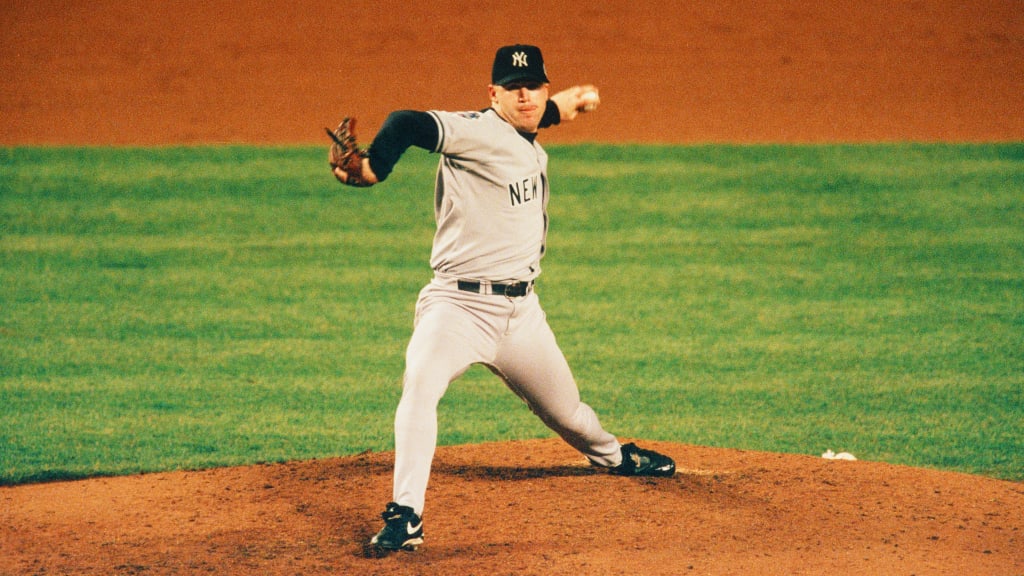Yankees Mag: Proven Winner
Mike Stanton thrived in October by always looking forward. Now, the three-time World Series champ looks back

Mike Stanton had come so far. He had already experienced almost everything the game of baseball could offer. He had made an improbable climb from a rural Texas community college to the Majors. He had experienced World Series heartbreak, and he had also enjoyed the highest of October highs.
But when Yankees manager Joe Torre sent the left-hander to the mound in the 11th inning of Game 1 of the 2000 World Series -- and several more times over the days that followed -- Stanton quickly realized that, more than anything else, he had to succeed in these moments.
Now almost 25 years in the rearview mirror, the Subway Series against the Mets remains one of the most significant events in New York City’s sporting history. Even though the Yankees entered that season having won three of the previous four championships, the thought of defeating the Mets to win a third straight title excited those within the organization and the fanbase like no other Series. The idea of losing the Fall Classic to the crosstown rivals seemed unimaginable and unacceptable.
“The underlying theme, which came from George Steinbrenner, was that we could not lose that one,” Stanton said in January from The Woodlands Baseball Academy in Magnolia, Texas, where he gives pitching and hitting lessons. “Not that losing any of the other ones would have been OK, but this was a must-win.
“It was just a little different rhetoric or chain of thought. We weren’t playing San Diego or Atlanta. This was the Mets; this was New York City. It went back decades to when the Yankees played the Dodgers or the Giants in the World Series. The whole world was focused on New York City. But we had done it before. We felt like this was our world, and the Mets were new to it.”
As if the Boss’ mandate didn’t put enough pressure on his players, the Yankees were also hearing a voice from an outfielder in Queens that added to the intensity.
“Benny Agbayani said that we were old and maybe not at our best anymore,” Stanton remembered. “The last thing that you wanted to do was poke the bear. Not that we needed additional motivation, but that didn’t help them.
“We didn’t really react to it, other than making a few little comments. We just went into that World Series thinking that we would show them how good old people can play baseball, because we were pretty good at it.”
Facing October stalwart Andy Pettitte in Game 1, the Mets took a 3-2 lead into the ninth inning, but the Yankees tied the game against closer Armando Benítez thanks to a Chuck Knoblauch sacrifice fly that plated Paul O’Neill.
After Mariano Rivera shut the Mets down in the top of the 10th, O’Neill hit into a double play with the bases loaded in the bottom of the frame. Then, as Torre had done so many times during Stanton’s seven seasons in pinstripes, he turned to the veteran reliever to hold the game in place just long enough for one of the many postseason heroes from that era to break through.
“We had such strong confidence in our offense that I felt like if I could just keep putting up zeroes, our hitters were going to do what they needed to do,” Stanton said. “I was locked in mentally.”
Stanton retired the Mets in order in the 11th and again in the 12th, striking out the last two batters he faced. In the bottom of the 12th, Tino Martinez and Jorge Posada delivered clutch hits before José Vizcaíno -- a journeyman infielder whom the Yankees had acquired earlier that season -- rapped a game-winning single to give the Yankees a 4-3 victory in the Fall Classic opener.
“We were just men at work, and I’m not talking about the ’80s music group,” said Stanton, who also currently serves as a TV broadcaster for the Houston Astros. “We were just doing what we were paid to do. We were not paid to play baseball; we were paid to win baseball games.”
The teams split the next two drama-filled games, setting up a pendulum-swinging contest in Game 4 at Shea Stadium. Stanton was called upon to help his team preserve a one-run lead in the seventh inning. With a runner at first, Stanton struck out the two batters he faced and, in effect, put the game into the hands of Rivera, who pitched two scoreless frames to save the 3-2 win.
Torre called on Stanton again the next night, this time in the eighth inning of a 2-2 game. Stanton served as the perfect bridge between Pettitte and Rivera, retiring the Mets in order. The Yankees scratched across two runs in the top of the ninth, and in front of a hostile Shea Stadium crowd, Rivera sealed the game and the Subway Series when he got fellow future Hall of Famer Mike Piazza on a long fly ball to center field.
Stanton’s work in the five-game series -- 4 1/3 innings of shutout ball with two wins and a hold -- in a lot of ways represented the mountaintop in a baseball journey that began decades earlier. But, if not for a combination of hard work and some good luck, the destination could easily have been far away from the bright lights of the Big Apple.
***
At Midland High School in southwest Texas, Stanton reveled in competing on a different playing field.
“I lived the Friday Night Lights thing,” the 57-year-old said. “I liked baseball, but football was the draw there. The way people look at it is that if you didn’t play football, you really didn’t play a sport. Back then, sports were played in one season, unlike the way it is now. Baseball was something that I did in the spring, just because there wasn’t any football. I enjoyed playing baseball, but football was my first love.”
On the gridiron, Stanton had a reputation as a player who never came off the field. He played running back on offense and linebacker and safety on defense. As he went into his senior season, he had already garnered serious interest from the University of Arkansas, and he was primed to embark on a college career with the Razorbacks.
Then, a twist of fate intervened.
“We were playing Andrews High School in the preseason,” he said. “I already had 70 yards on three carries. On defense, a guy went low to block me and took out my knee. That was the beginning of the end of my football career. I had some cartilage damage, and I missed a few weeks. I also had another injury later that year. I was good, but I wasn’t a blue-chip player. Considering that Arkansas played on turf, the knee injuries compelled them to back off.”
On the diamond, Stanton was also a two-way player, excelling as a hitter and taking the mound when needed. According to the 19-year Major League veteran, he only threw about 12 innings during his senior season in Midland. Hoping to continue playing baseball at the collegiate level, Stanton followed in the footsteps of his high school teammate, Mike Timlin, who would later have his own successful big league career, primarily with the Blue Jays and Red Sox. With Timlin already pitching for Southwestern University in Georgetown, Texas, Stanton tried out for the NAIA baseball program.
“I went to the tryout with the catcher from our crosstown rival in high school,” Stanton said. “It had rained like crazy that day, and the field was drenched. We actually took batting practice out in left field because the condition of the rest of the field was so bad. We both swung the bat pretty well, but we had no idea if we were going to be asked to enroll there and join the team.”
Then, another twist of fate that so easily could have gone the other way took place in Stanton’s life.
“As we were walking off the field, I told the head coach and the pitching coach that I could pitch, too,” Stanton said. “At first, he said, ‘OK, I’ll keep that in mind.’ Then the two coaches got together and decided to have me throw right then and there.
“I had no training at how to pitch; no coaching whatsoever. I threw some pitches, and we went out for lunch on campus. Right after that, the head coach offered me a half scholarship as a pitcher and outfielder. But, as it turned out, that was the end of me being a position player. The coach had a standing rule that if you were one of the top pitchers, you didn’t hit. I must have been his No. 5 pitcher because I didn’t hit or do any outfield drills from Day 1.”
Things didn’t work out as planned for Stanton at Southwestern. His performance on the mound would have afforded him a second season, but his grades did not.
“I wasn’t the most diligent student,” Stanton said. “I viewed myself as an athlete, someone who was getting paid to play a sport.”
Determined to keep his baseball career going, Stanton reached out to Gary Bullion, the head coach at Alvin Community College, located about 30 minutes away from where Stanton’s parents had recently moved. When the two spoke, Bullion remembered watching his team face Stanton a few months earlier.
“To this day, I can’t remember facing them the previous fall,” Stanton said. “But I’m glad that Coach Bullion remembered me.”
Bullion offered Stanton a spot on the Dolphins’ pitching staff.
“He wasn’t able to give me any type of scholarship because of my grades,” Stanton recalled through a laugh. “But he offered to give me some books that were left over.”
Stanton embraced the opportunity and quickly made the most of it, beginning the season as Bullion’s No. 2 pitcher.
“Our season started in a tournament,” Stanton said. “The No. 1 starter pitched a one-hitter in the first game, and I followed that up with a no-hitter. We were playing in one of the best junior college conferences in the country, and Alvin was a really good program.”
Following the hot start, Stanton experienced a series of events that changed the trajectory of his life.
Later that season, he took on San Jacinto College in Houston, a perennial powerhouse known for producing major league players such as Pettitte and Roger Clemens, among others.
“San Jac was at their height back then, and I had thrown the ball pretty well that season,” Stanton said. "[Longtime head coach] Wayne Graham had a Division I team in terms of how good they were. It was a school where you went to get drafted. I came into the game against them in relief, and I gave up four home runs in one inning. I was throwing the ball as hard as I could, but they were teeing off against me.
“I was mentally shot after giving up those four home runs and was told that I would not be pitching against Laredo Junior College the following Sunday. I stayed up late on Saturday night like a lot of college kids do, and I showed up at the ballpark on Sunday in turf shoes.”
Not long after the game got underway, the plan started to change. With Alvin’s starter struggling to get out of the first and second innings, Bullion called an audible.
“I’ll never forget hearing, ‘Stanton, go warm up,’” the former Yankee said.
As fate would have it, Stanton put himself on the radar of Major League scouts in that game. He threw 10 2/3 scoreless innings, and like he did all those years later against the Mets, he kept his team in the game until their offense could win it.
“I didn’t know that there was something known as the scouting bureau back then,” Stanton said. “The way it worked was that someone from the bureau would be at as many games as possible. If they saw something relevant, they would send that information to all of the Major League clubs.”
Stanton recalled that Atlanta Braves scout Red Murff -- famous for having drafted Hall of Fame pitcher Nolan Ryan -- showed up to watch him pitch four days later. In that Thursday start, Stanton shut out Blinn College for six innings and then heard a pop in his elbow after “overthrowing a pitch.”
“After I came off the field with the elbow injury, the guy from the scouting bureau closed his book and walked off,” Stanton said. “But Red Murff, being the old-school guy that he was, came up to me after the game.”
“‘I need you to be honest with me,’” Stanton recalled the scout saying. “‘Are you hurt or is this an injury?’ In other words, are you just sore or is there something wrong?”
Stanton was confident that he was fine.
“I didn’t think I did anything,” Stanton said. “I just felt like I overthrew a curveball and hyperextended my arm. I took a few weeks off and came back right before the playoffs. We made the state tournament at Alvin for the first time in their history, and I pitched in relief. I was able to warm up a few times and show the Braves that I was healthy.”
Murff must have believed him because on his 20th birthday, Stanton was selected by Atlanta in the 13th round of the 1987 Draft.
“I was at home at Clear Lake, sitting at the kitchen table with my parents when I found out that the Braves had drafted me,” Stanton said. “I wanted to sign with the Braves, and my parents wanted me to continue on toward getting a four-year degree. We were able to put college in the contract I signed with the Braves. They were going to pay for five semesters with some stipulations. Of course, the Braves got out of that because of how long I ended up playing.”
***
Stanton’s big league career was indeed long -- 19 seasons -- and the time it took to work his way up through the Minors was quick. Two years after being drafted, Stanton made his Major League debut with Atlanta, saving seven games down the stretch for the 1989 Braves.
“The Braves had drafted pitchers with their first-round picks for four years in a row,” Stanton said. “That’s how they went about their business, by drafting pitching. With three left-handed starters in front of me, I went into the ’pen during the 1989 season. I was the closer in [Double-A] Greenville and then got promoted to [Triple-A] Richmond. I only pitched in 13 games in Richmond before getting called up.”
It took Stanton until the beginning of the 1991 season to earn a permanent spot on the big club. But what a time it was to have arrived in Atlanta. The Braves won the National League East 14 out of the next 15 years -- only falling short in 1994, when the postseason was canceled as the result of a work stoppage.
Stanton was part of that run for four and a half seasons, pitching in the World Series in 1991 and 1992. Although the Braves came up short in those Fall Classics, Stanton was a big reason why they got there. The reliever pitched in a team-high 74 regular-season games in 1991, posting a 2.88 ERA. In that postseason, he allowed one run in eight appearances, including a crucial Game 7 World Series appearance in Minnesota.
In that eventual Twins victory, Stanton took the ball from Hall of Famer John Smoltz in the eighth inning of a scoreless game. With the bases loaded and one out, Stanton got Twins first baseman Kent Hrbek to line into an inning-ending double play.
Stanton came back out in the bottom of the ninth but couldn’t finish the frame.
“I threw [Twins star] Chili Davis something like nine fastballs in a row to start the inning,” Stanton said. “He finally was able to drop one into center for a single. The next hitter bunted, and the baseball went right over the top of the mound. I initially turned toward third, but I had to turn back toward first to get the ball. When I turned to get it, I did something to my back. I went down to a knee to pick up the ball, but I couldn’t get back up. I was actually carried off the field because my back had locked up.”
The Twins won the World Series in the bottom of the 10th, and for Stanton, that would be the first of several experiences in which he nearly won it all, only to miss out on October glory. The Braves got back to the Fall Classic the next season, but fell to the Toronto Blue Jays. Then in 1995, after Stanton was traded to the Red Sox, Atlanta finally broke through, winning its first World Series. In that same postseason, Stanton’s Red Sox fell to Cleveland in the ALDS.
***
With the hopes of finally winning a championship, Stanton signed a free-agent contract with the team that had knocked his 1996 Texas Rangers out of the playoffs. Prior to the start of the 1997 season, Stanton joined the Yankees at 30 years old. With Rivera now the team’s closer for the first time, Torre had the perfect setup crew in Stanton and Jeff Nelson.
Stanton was brilliant from the start of his pinstriped tenure, posting a 2.57 ERA in his first regular season in the Bronx. But, that postseason, Stanton’s championship dreams would again be ruined by Cleveland, which overcame a 2-games-to-1 deficit in the best-of-five ALDS with a pair of one-run victories.
“The idea that I was always looking forward actually helped me in respect to having not won a championship to that point,” Stanton said. “Even though there were a lot of near-misses for me, the past never really came into my mindset.”
Stanton and his teammates were never so focused on the future as they were after the disappointing end to the 1997 season.
“We felt like we had the best team in 1997,” Stanton said. “I really feel like the 1998 season began the day the 1997 season ended. We all felt like we had unfinished business from 1997.
“We knew how good our team was going into Spring Training of 1998, and we refused to be complacent.”
With that mantra, the Yankees avenged a slow first week on the West Coast, winning a then-American League-record 114 regular-season games.
“It just seemed like from the time we got back to New York for Opening Day, we didn’t lose,” Stanton said. “It was almost like, whenever we lost a game, we got ticked off, and we would go out and win six more in a row until we lost a game and got mad again.”
In a rematch with Cleveland, the Yankees suddenly found themselves trailing, 2-games-to-1, in the ALCS. In Game 4 at Jacobs Field, clutch starter Orlando “El Duque” Hernández gave the Yankees seven scoreless innings. With the Yankees ahead, 3-0, Hernández walked the leadoff batter in the eighth, prompting Torre to bring in Stanton. The reliable lefty kept Cleveland off the board that inning, as did Rivera in the ninth. The Yankees tied the series that night and won the pennant a few days later.
“You never know,” Stanton said. “If we lose that game, it’s probably over. Cleveland was good. They didn’t have the pitching we had, but their offense was incredible. Their fans were brutal; they were selling out Jacobs Field for every game. It was an electric atmosphere. We fed off of that. When you’re playing in a hostile environment, that just adds to your drive. Cleveland was a tough place to play. The fans were boisterous, and there were times when they crossed the line.”
Stanton, who finished his 19-year career in 2007 with a 3.92 ERA in 1,178 games, finally won it all when the Yankees completed a sweep of the San Diego Padres in the 1998 World Series.
“It was an incredible season,” Stanton said. “It will never be duplicated. I mean, 125 wins in a season … that’s ridiculous.”
In the season between the historic accomplishments of 1998 and the dramatic Subway Series victory of 2000, the 1999 Yankees were pretty special in their own right. That team swept the Atlanta Braves in the Fall Classic, setting up the most recent three-peat in the sport.
“If there’s a team that’s probably overlooked, it’s that 1999 team,” Stanton said. “The way that 2000 ended with us beating the Mets, that always sticks out in your mind. In some ways, 1999 was a bit of a hangover from 1998. We had finished what we wanted to accomplish in ’98, but everyone’s mindset was the same the following spring. What we did was great, but if we really wanted to be a historic team, then we had to do it again. When you look at it that way, what we did in 1999 was just as important as what transpired during the other seasons.”
During those three postseasons, Stanton took the mound 15 times. He only allowed the opposition to score on him in two of those games -- including in Game 2 of the 1998 World Series when he still protected an eight-run lead. Those near perfect October performances during the Yankees’ three-peat is still hard for the humble pitcher to wrap his head around.
“It’s almost like you’re talking about someone else,” Stanton said. “It would have been nice if I could have realized what was happening and enjoyed it a little bit back then. But, again, that mentality of just pushing forward -- we did our job today, we have to do it again tomorrow -- that was my approach to the innings I pitched. I look back at it and take pride in it. I also sometimes ask myself if that was really me.”
Stanton’s contributions to the teams he was on in New York -- including the 2001 squad that lost to Arizona in Game 7 of the World Series -- were essential to that monumental dynasty. As impressive as that may be, Stanton’s most historic feat actually began in 1991 with the Braves and lasted through the end of his initial Yankees tenure in 2002. (He also made 28 appearances for the club in 2005.) Not only did Stanton pitch in 11 consecutive postseasons, but he also left the game as one of the most successful relief pitchers in postseason play, recording a 2.10 ERA in 53 playoff appearances.
When asked how he did so well, so consistently, in so many big games, the 2001 All-Star shrugged his shoulders.
“I have always felt that pressure is self-imposed,” he said. “A situation can not put pressure on a player unless the player elects to feel the pressure.”
Alfred Santasiere III is the editor-in-chief of Yankees Magazine. This story appears in the June 2024 edition. Get more articles like this delivered to your doorstep by purchasing a subscription to Yankees Magazine at www.yankees.com/publications.



